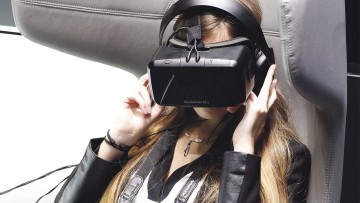When Isaac Asimov, the legendary sci-fi writer, penned an essay for The New York Times about what the world would look like in 2014, he accurately predicted the emergence of 3D TV sets, driverless cars, robotic maids and online education, albeit by closed-circuit television.
Yet Asimov’s vision of automated kitchens that prepare “auto-meals” – akin to the foodrackacycle in TV’s The Jetsons – proved wide of the mark as did his prediction that electroluminescent panels would adorn every wall and ceiling that could change colour depending on the mood.
The irony is that Asimov wrote in a format – books and journals – that could soon feel as antiquated to future generations as the giant gramophone does to us. The living room of the future will not have room for a bookcase, merely some sort of receptacle to house all the charging units for the dozens of devices we will use to control our entertainment needs.

Of course, much depends on the hardware that is emerging. The telecoms industry spent years trying to get TV on to mobile phones, but did not predict that over-the-top sites, such as YouTube, Facebook and Twitter, would corner the market with short-form videos.
For all the predictions, the living room has not changed too radically in recent years. Racks of DVDs, CDs and portable TVs may have been replaced by tablet computers and wireless speakers, but the configuration of the room remains roughly similar. As Deloitte noted in a recent report: “Most items are selling in the hundreds of thousands as connected devices, sensors or controllers; very few are selling in their millions.”
We’re now going into a period which will see a high level of experimentation, with manufacturers building the new technologies into products in novel ways
However, the launch of Apple’s HomeKit and Google’s Works with Nest could finally unleash a wave of domestic innovation as more consumers opt to connect up their homes and take advantage of bespoke systems. More ordinary devices will be co-opted to support our digital needs. Even the humble light bulb is being transformed into a wi-fi hub and a speaker with companies, such as Sengled Optoelectronics in Shanghai, working on very smart lighting indeed.
“The set up in the living room has been stable for many years. We’re now going into a period which will see a high level of experimentation, with manufacturers building the new technologies into products in novel ways,” says Martin Garner, an analyst with CCS Insight.
The TV, which has slimmed down in recent years, is only going to get smarter. But it could disappear altogether as companies such as Sony develop projectors, like its 4K Ultra Short Throw Projector, which turns a wall into a giant TV screen. Those that stick with their monitors will also discover that the set offers a host of new features, such as search and statistics during football games, as the likes of Panasonic and Samsung try to wrestle more eyes back from the smartphone by adding data on to the larger screen.
“With video, we’ll see projectors used to turn most of a wall into a TV screen. We’ll also see the TV user experience reinvented to show a lot more information from the web that’s relevant to what you’re watching, for example sports statistics, actors and actresses in a movie,” says Mr Garner.
The biggest changes could occur in the field of sound. Technology showcased at the Consumer Electronics Show in Las Vegas painted a picture of a living room where speakers can offer 3D surround sound, such as Samsung’s Omni Directional speakers, which look like tripods, but promise to offer a 360-degree aural experience.

Perhaps more pertinent for households already populated by people with different devices consuming different types of media is the emergence of technology that can create “audio zones”, discrete areas which tune out the background noise.
Key to any change is the network used to connect the array of TVs, computers, smart metres and home surveillance systems. Researchers at Forrester estimates that 11 per cent of Europeans already have six or more devices hooked up to home wi-fi networks, but it is more likely that layers of different networks will be needed in the future to operate the dozens of systems used to communicate with each other and entertain ourselves.

The head-mounted Oculus Rift
An example of the network-centric view of the future living room is the move by regulators to open up the airwaves for 5G mobile networks with the prospect of holographic projections, like those seen in Star Wars.
Less clear is the world of immersive media – virtual or augmented reality – despite the amount of investment that the likes of Google have poured into test products such as Google Glass in recent years. Glass, as a standalone product, has been shelved and there is as yet little insight into how Oculus Rift, the virtual reality headset bought by Facebook, will be adapted for a mainstream audience. Facebook has been teasing a “teleportation station”, which is expected to mean an Oculus-based technology that will allow the wearer to visit remote locations as if they were making a Skype call.



